"Investing is not nearly as difficult as it looks.
Successful investing involves doing a few
things right and avoiding serious mistakes"
The month of November 2023 brings back the lustre
which was lost during the last 2-3 months. The festive
month started with a dreary note, but then the Nifty 50
paced up touching all-time highs. Indian stock markets
stood 4th around the world touching $4 trillion of market
capitalisation. The market valuation of BSE-listed
companies crossed a record $4 trillion for the first time
on November 29, on the back of positive market
sentiment in Indian equities. The market capitalisation of
BSE-listed companies reached ₹333 lakh crore, or $4
trillion at the exchange rate of 83.31. It has climbed over
$600 billion since the beginning of the year. BSE-listed
firms hit the $1-trillion market cap milestone in May 2007
and it took over 10 years to double. The market cap
surpassed $2 trillion in July 2017. BSE m-cap had hit the
$3 trillion mark in May 2021. Small-cap and mid-cap
categories have outperformed amid the global easing
policy actions. This was triggered post US banking crisis
and strong margin outperformance driven by input cost
moderation.
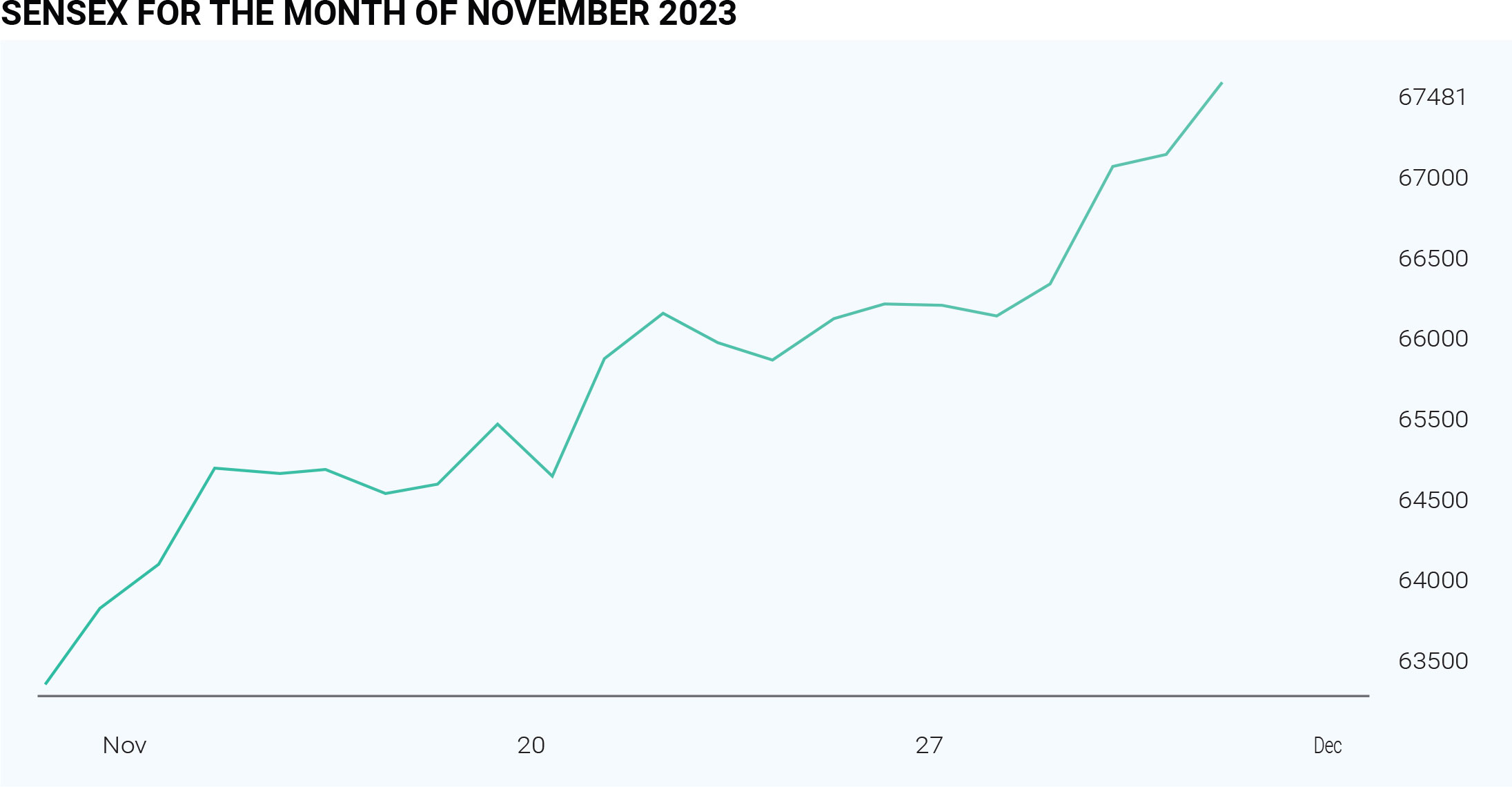
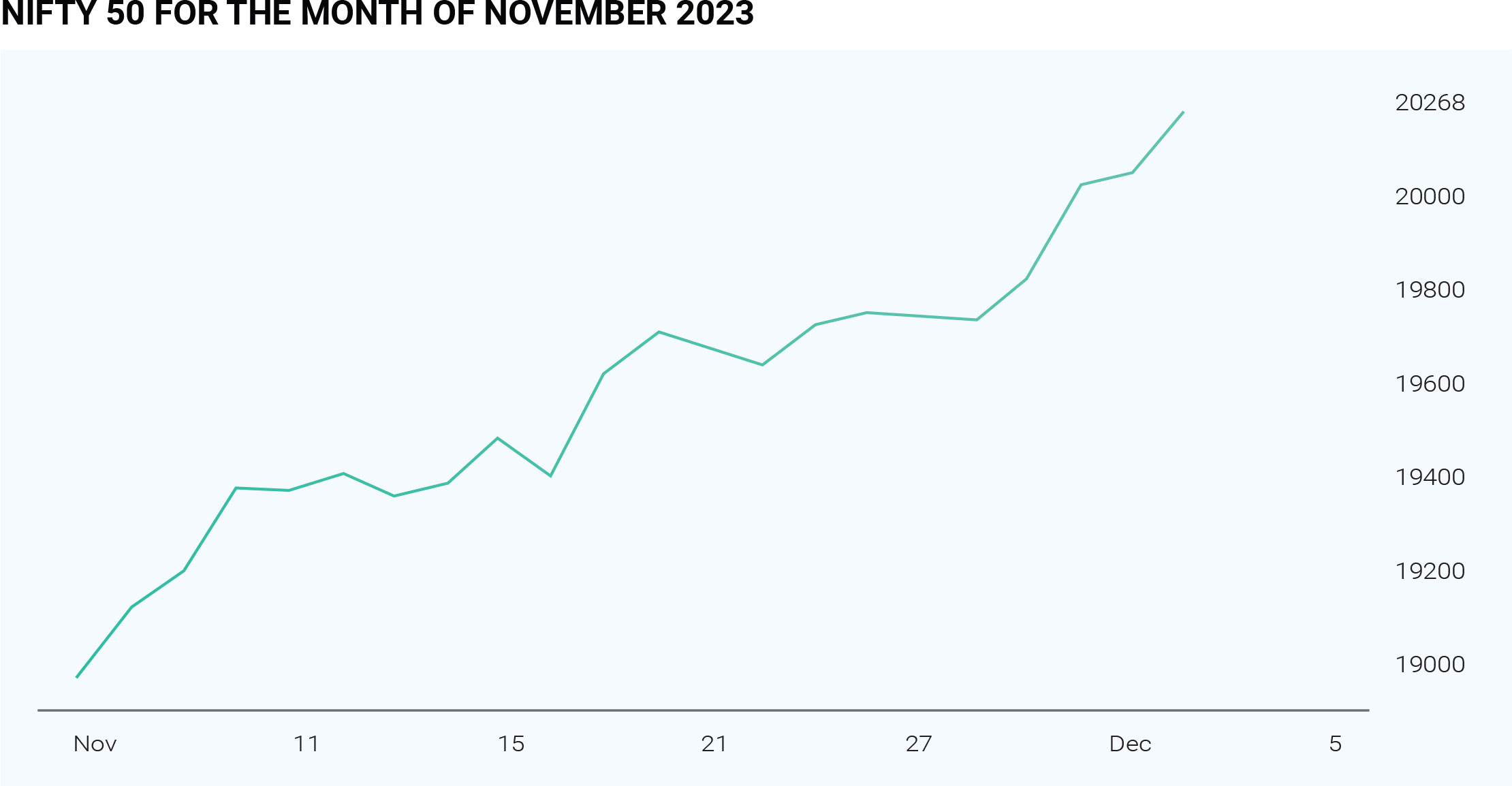
The major factors contributing to this upsurge were
robust economic numbers, favourable exit polls, and the
return of Foreign Portfolio Investors (FPIs) to the Indian
markets. The Indian economy grew by 7.6% during
Q2FY24, maintaining its position as the fastest-growing
major economy globally. India's Q2 GDP growth
surpassed both market estimates and projections by the
Reserve Bank of India. Recently, CLSA stated that it
anticipates India's soaring GDP growth will propel it to
the top three of the world’s largest economies, increasing
from $3.4 trillion today to surpass Japan’s by 2027,
reaching $29 trillion by 2047, and further expanding to
$45 trillion by 2052. By then, only China and the US will
have larger economies, with the possibility of India
overtaking the US economy in size by 2052 if significant
reforms unleash efficiencies.
The exit polls for the five state elections indicate political
stability ahead of the General Elections in 2024. A
decisive win for the BJP would strengthen the consensus
view that the party is well-positioned for the 2024 general
elections. This outcome is likely to further boost market
confidence, as policy continuity is viewed positively for
medium-term growth. The market favours political
stability and a reform-oriented, market-friendly
government."
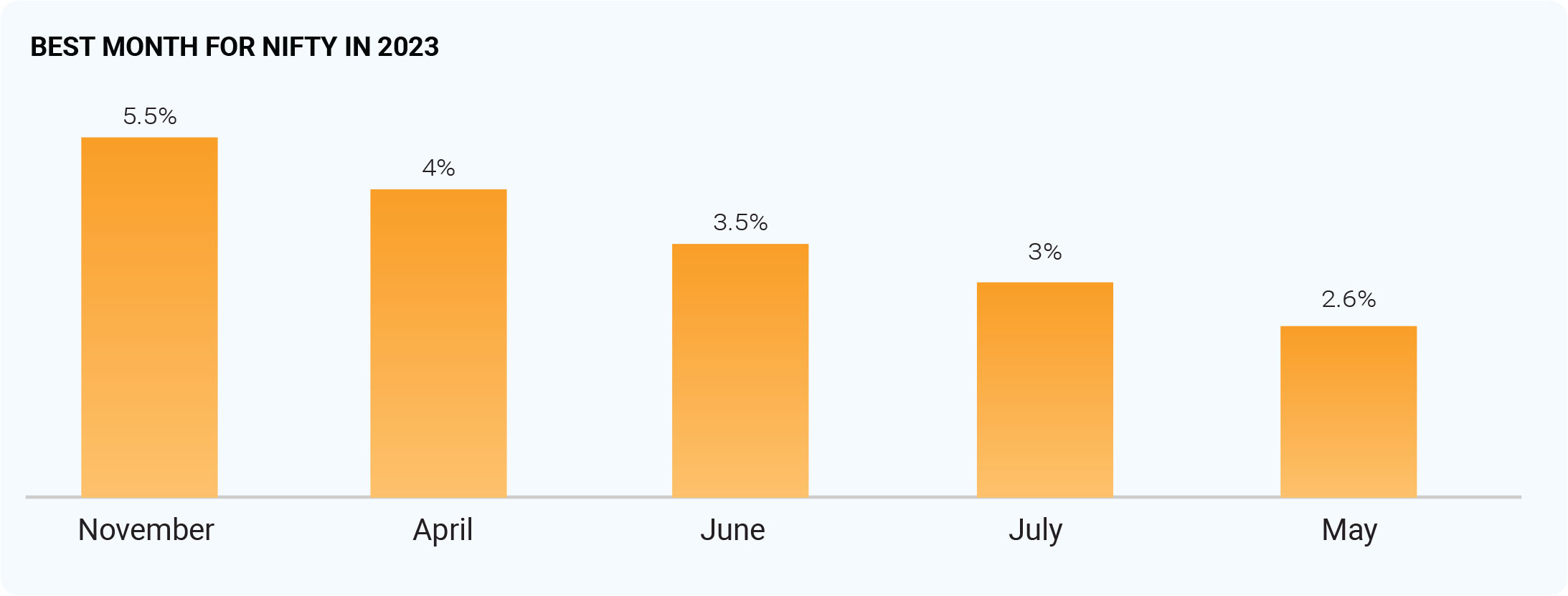
After a two-month hiatus, Foreign Institutional Investors
(FIIs) made a comeback as net buyers of Indian equities,
injecting a total of ₹13,474 crore over only six sessions.
In November, Foreign Portfolio Investors (FPIs) ended a
two-month selling streak, recording a net inflow of
₹9,001 crore. This marked a significant shift from the
over ₹39,000 crore worth of shares sold in September
and October. Foreign portfolio investors displayed a
distinct preference for larger sectors, particularly
financials, FMCG, and oil and gas. Moreover, FPIs in the
domestic debt market reached a six-year high in
November, driven by robust yields and the inclusion of
domestic bonds in JPMorgan's Emerging Market Global
Bond Index. Data from the National Securities Depository
Ltd. reveals that foreign portfolio investors infused Rs
14,556 crore as of November 29. The decline in US
treasury yields and the softening of the dollar, coupled
with rising speculation that the US Federal Reserve has
concluded its key interest rate hikes, have triggered
foreign fund inflows into emerging markets, including
India.
Last month, global pressures took a favourable turn. Oil
prices sharply dropped to $80/bbl due to a slowdown in
the growth of China and European nations. Additionally,
the expected soon-to-be Venezuelan crude supply added
to the decline. The decrease in crude oil prices is
anticipated to help India improve its current deficit
projections. Lower-than-expected inflation readings led
to a significant correction in US bond yields. From close
to 5%, 10-year yields dropped to approximately 4.5%. This
subtle change also attracted Foreign Portfolio Investors
(FPIs) inflows. The US market rallied almost 10% in the
month of November. US 10-year bond yields and the
dollar index were cooling off, providing strength to the
market. This decline in yields gained momentum amid
growing speculation that the U.S. Federal Reserve might
initiate interest rate cuts next year. FOMC minutes stated
that in the upcoming months, data would help clarify the
extent to which the disinflation process was continuing,
aggregate demand was moderating in the face of tighter
financial and credit conditions, and labour markets were
reaching a better balance between demand and supply.
As markets reach new highs, the prevailing risk cannot
be ignored. Amid expectations that the central bank will
maintain the benchmark interest rates, the rate-setting
monetary policy panel, led by RBI Governor Shaktikanta
Das and consisting of six members, will commence
deliberations in the upcoming week. The three-day
meeting is scheduled from December 6 to December 8,
with the decision to be announced on Friday. The RBI has
held the repo rate steady at 6.5% since February of this
year. This marks the central bank's fourth MPC meeting
for fiscal 2023-24 and the final one for the calendar year
2023. The market anticipates the central bank to retain
its current stance, given that India's retail inflation
persists above its 4% target. The US Fed chairman
mentioned that inflation is steadily slowing, but it is
premature to declare victory or discuss potential interest
rate cuts. Powell reiterated the central bank's
commitment to a cautious approach on interest rates,
noting that the hoped-for 'soft landing' of the US
economy appears to be materializing. Meanwhile, global
markets, including the European Central Bank, are
experiencing bullish trends. The European Central Bank
concluded its rate-hiking cycle in response to easing
inflation.
As markets move at lightning speed, regulators are
closely monitoring derivatives traders and major sectors,
particularly banks. SEBI has issued repeated warnings to
retail investors, emphasizing the need for caution in
derivatives trading. In the Indian market, the banking
sector, a favourite among investors, has seen impressive
gains. However, the RBI is actively working to address
defaulters and implement changes in rules and
regulations.
As we approach December, several significant
challenges loom on the horizon, including the FED rate
decision, MPC meeting, global festivals, unpredictable
geopolitical tensions, and global inflation. All these
factors could potentially impact market movements in
the future. Despite these challenges, there is hope that
the year will end on a positive note for the Indian stock
markets.
At the beginning of the current financial year, NSE Indices
Ltd, a subsidiary of the National Stock Exchange (NSE),
introduced India's first-ever Real Estate Investment
Trusts and Infrastructure Investment Trusts index — Nifty
REITs and InvITs Index. This index is designed to monitor
the performance of publicly listed and traded REITs and
InvITs on the NSE. It was a highly anticipated investment
tool for the real sector in India. The Indian government
launched InvITs and REITs to attract long-term yield
capital into the country and stimulate private
participation in infrastructure and real estate. Analysts
predict that the real estate sector in India will grow to a
market size of US$1 trillion by 2030. Despite near to
medium-term challenges from COVID-19, the long-term
drivers for real estate demand are robust and likely to
endure current adversities. The REIT/InvIT route has the
potential to address several investment challenges in the
infrastructure sector.
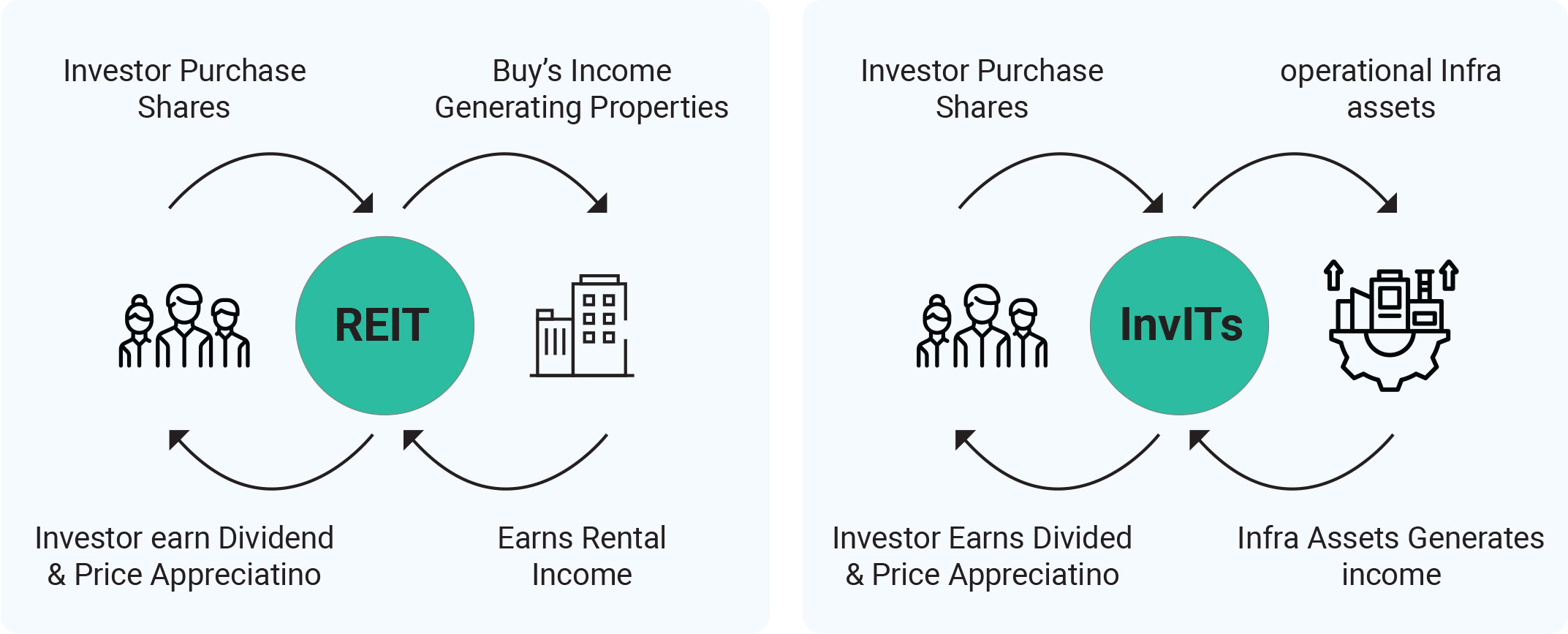
REITs and InvITs are conceptually akin to mutual funds,
where a sponsor raises capital and invests in
infrastructure or real estate projects. A Real Estate
Investment Trust (REIT) or an Infrastructure Investment
Trust (InvIT) is an investment vehicle that owns
revenue-generating real estate or infrastructure assets.
While REITs invest in real estate projects, InvITs focus on
infrastructure projects with a longer gestation period.
These trusts provide investors with exposure to
diversified, regular income-generating real estate and
infrastructure assets, making them strong financial
instruments for those seeking involvement in these
sectors.
The Nifty REITs and InvITs index comprises securities
based on their free float market capitalization, subject to
a security cap of 33% each, with the aggregate weight of
the top three securities capped at 72%. The index has a
base value of 1,000 and undergoes quarterly reviews and
rebalancing. It serves as a benchmark for fund portfolios
and index variants.
For securities to be eligible for inclusion in the index, they
must meet certain criteria:
- REITs or InvITs must be domiciled in India and listed and traded on NSE; only publicly listed securities are eligible.
- Securities should have a market lot size of 1 unit for inclusion.
- A minimum listing history of 1 month as of the cutoff date is required.
- Securities should have a minimum trading frequency of 60% during the previous 3 months as of the cutoff date.
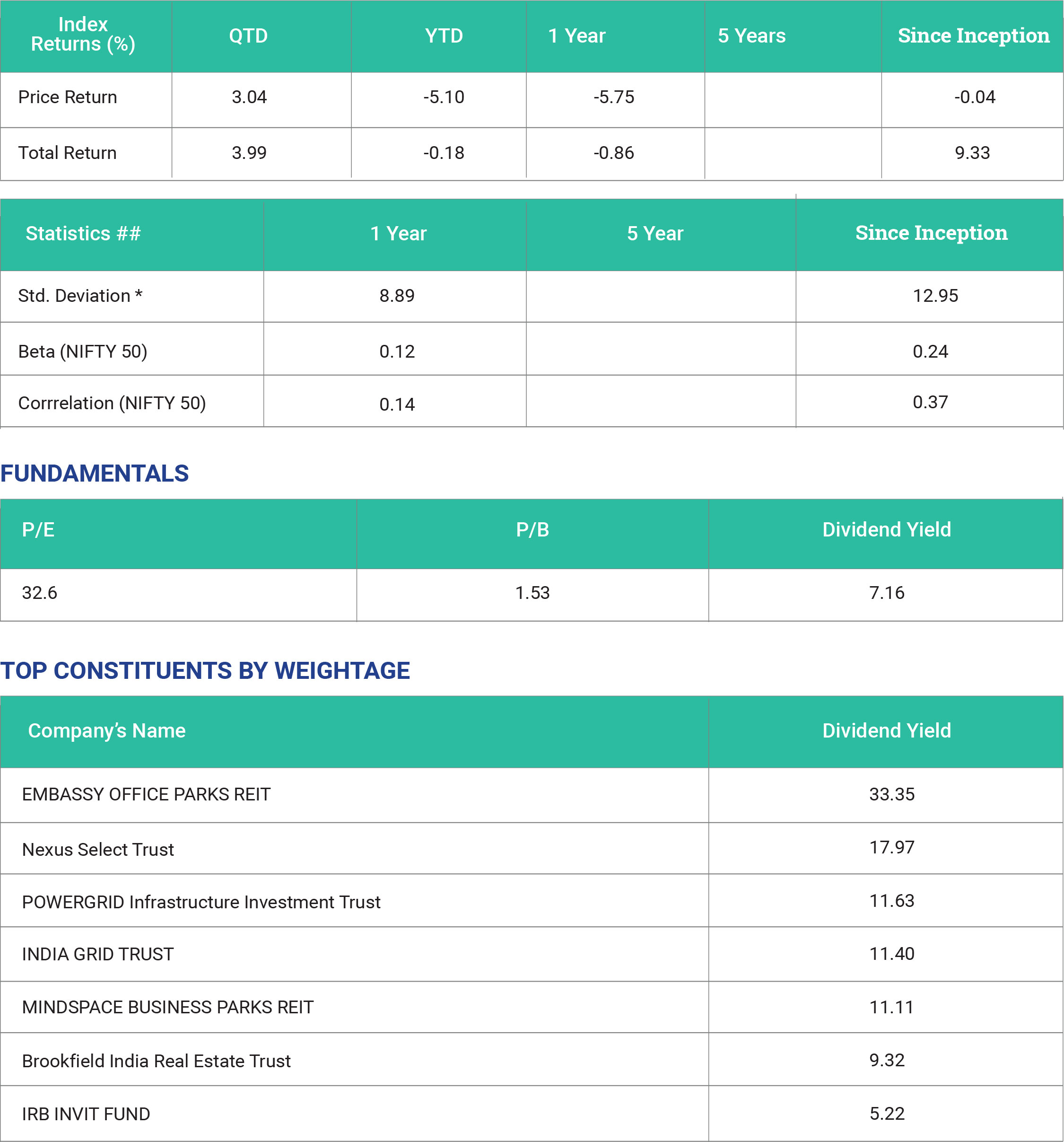
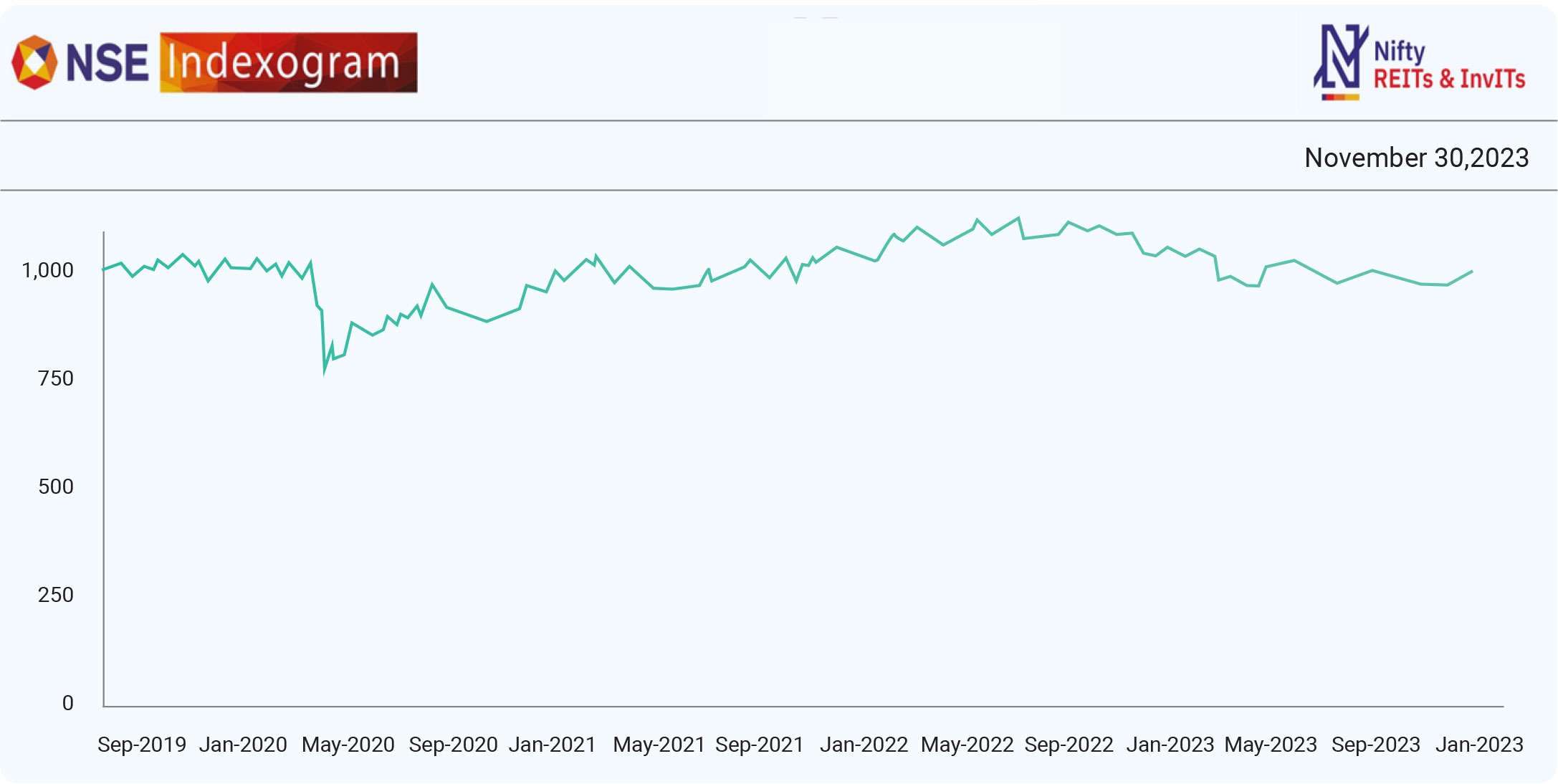
SEBI has consistently worked on strengthening the
regulatory framework for REITs and InvITs. To enhance
the efficiency of the public issue process, the time for
allotment and listing after the closure of REITs and InvITs
issues was reduced from 12 to 6 working days. For
privately placed InvITs, the timeline was shortened from
30 days to six working days, contributing to increased
market liquidity. According to SEBI, these innovative
mechanisms for financing real estate and infrastructure
can have a multiplier impact on India's economic growth.
SEBI has introduced rules granting special rights to REIT
unitholders, enabling them to nominate representatives
on the boards. Additionally, the concept of a
self-sponsored REIT was introduced. The market
continues to show interest in REITs and InvITs, with 3
new InvIT registrations and 1 new REIT registration
during 2022-23. The total registered entities now stand at
20 for InvITs and 5 for REITs. Listed REITs and InvITs
raised funds amounting to Rs 18,658 crore in the first
half of the current fiscal year, driven by robust demand
for infrastructure investment, attractive returns, and
supportive government policies. The data indicates that,
of this amount, Rs 12,753 crore was raised through
InvITs, and Rs 5,905 crore was collected via REITs. Tax
implications for REITs and InvITs are treated as
pass-through vehicles under income tax rules, with
income, in the form of dividends and interest from
underlying assets, being fully exempted. Distributions
made by investment trusts are directly taxed in the hands
of investors, depending on the nature of such
distributions (dividend, interest, or capital repayment).
It's worth noting that REITs and InvITs have different
income tax implications for sponsors, unitholders, and
the REIT or InvIT at various stages. With proactive
support from the government and regulatory authorities,
REITs and InvITs are being extensively promoted. High
levels of corporate governance from sponsors and
management are of utmost importance in establishing
these trusts. Maintaining consistent transparency in
financial reporting is crucial for building the foundation
for long-term success in this area. Given the sizeable
dependence of the Indian economy on infrastructure
development, these trusts have
become vital in addressing the country's infrastructure
needs. While REITs and InvITs are relatively new
concepts in the Indian market, they have been popular
choices in global markets due to their lucrative returns
and capital appreciation. This marks the advent of a new
era of growth driven by capital investments in REITs and
InvITs.
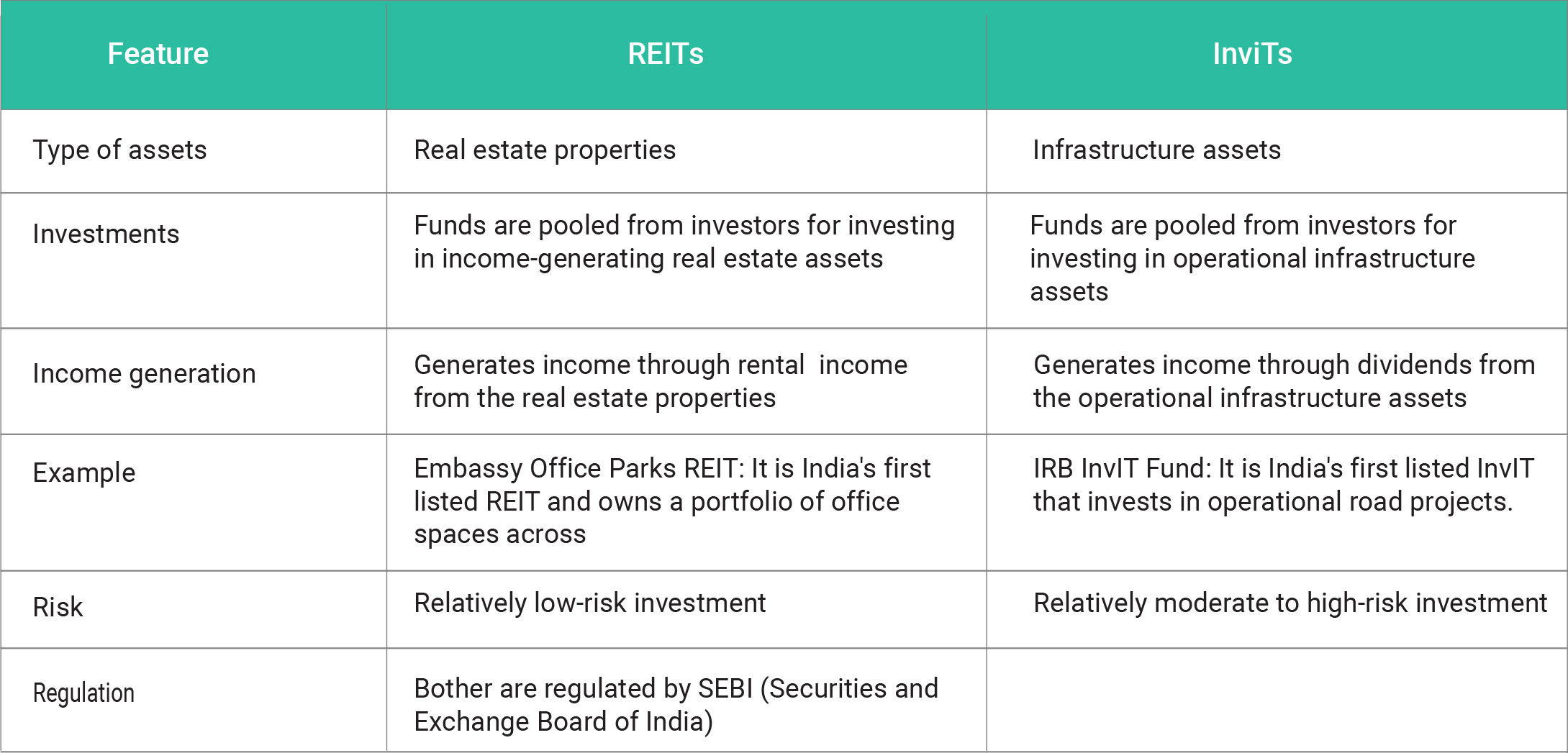
Copyright © 2021 Fintso
